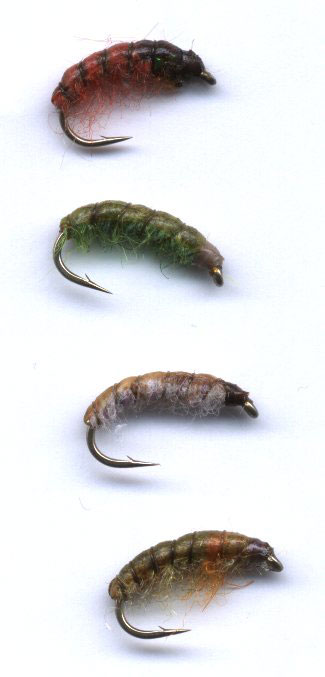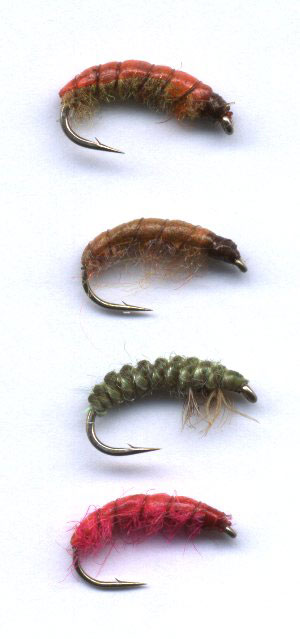Over recent years, few game anglers can have failed to hear about Czech Nymphing – a seemingly all-conquering grayling tactic for fast and deep water. This article aims to briefly describe the approach and flies utilised, and is based largely upon my own experiences of the last three or four years.
Czech nymphing was introduced to the UK in the 1990 World Championships, when the Czech team thrashed the UK International teams on the Welsh Dee. The Czechs caught grayling in numbers from places that were previously thought impossibly fast or deep and sent shockwaves through the world of competition angling.
 Following the inevitable further development, the technique is today considered to be pretty much a standard – certainly it is one that should be in every grayling anglers armoury.
Following the inevitable further development, the technique is today considered to be pretty much a standard – certainly it is one that should be in every grayling anglers armoury.
Firstly, let’s take a look at the flies:- The Czech nymph has many, many variations, but all are based upon one simple design, utilising a heavily-leaded hook.
Hook – Curved grub, sizes 6-12. e.g. Partridge K4A, Tiemco 2487, Drennan shrimp, Kamasan B100/B110
Weight – square-section lead wire or narrow strip cut from lead sheet.
Thread – 6/0 or 8/0 to suit body colour
Abdomen – Fine synthetic. I use Scintilla, but as this is now near-unobtainable in the UK, SLF Masterclass is probably the best. Use olives, browns, dirty yellows, greens etc. Above all, experiment! Some Czech nymphs have a bright pink/orange/red hotspot in the thorax area, although opinions are divided on whether it makes any practical difference. Ensure the abdomen is tied well round the hookbend.
Thorax – Hares ear/mask – two or three turns only.
Rib – Under-rib – fine/med wire or tinsel, in gold/silver or pearl.
– over-rib – clear nylon mono, about 3 or 4lb test
– Shellback – Narrow strip cut from latex surgical gloves. Or use one of the many commercial materials such as Bodyflex, Body stretch, Magic Shrimp Foil etc. I like to tint the shellback using a waterproof marker in brown or olive. Just lightly draw the pen over the back, and then wipe off. The effect is to subtly highlight the segmentation of the over-rib.
It is important that Czech nymphs are tied slim – no mean feat when considering the amount of lead that is used. They are intended to be fished v. deep, in fast water, so weight and a slim profile are important – I’ve recently experimented by tying some up using tungsten sheet (about 50% denser than lead – but somewhat more expensive & difficult to tie). For a northern angler more used to catching grayling on size 14’s & 16’s carrying mere wisps of mole and snipe, the transition to such large and heavily leaded hooks was not an easy one (and I’ve still not quite had the courage to go to 6’s!) No matter, have courage – part of the reason for such a large hook is so that it will carry more lead – it doesn’t seem to put the grayling off – if anything quite the reverse!
 Now, a look at tackle and tactics:
Now, a look at tackle and tactics:
A 5 or 6-weight rod will suffice. To date I’ve used my old, much loved #5, 8ft Diawa, although I have to admit that an extra foot or so would help greatly in better controlling the flies. I sense an imminent, pre-season trip to the tackle shop.
Leader should be of about 9′ in length. Don’t bother with tapered leaders, they are counter-productive. You will not be fly-casting in any accepted sense, and a tapered leader won’t sink quickly enough. Just use something like 6lb down to the top dropper, with 4lb thereafter. Use two 5-6″ droppers, one about 18-20″ above the point fly, the other about 18-20″ above that. The ‘pukka’ Czech method is to fish the heaviest nymph on the top dropper, so that it helps carry the other flies down to the correct level. Whilst I appreciate the principle, I remain to be convinced as to the practice!
To help ensure rapid sinking of the flies, scrupulously degrease the leader, right up to the flyline. I use a classic fullers earth, glycerine and washing-up liquid mixture, rubbed well into the line. You’ll be looking for takes on the end of the flyline, so depending on your eyesight you may wish to use some sort of indicator (I use a small ‘sausage’ of fluorescent float-do, worked into the braid connector loop).
Now to actually catch something!
You’ll be attacking fast, streamy water – the sort of water that you might normally think was near-unfishable on the fly. Typically I’d look for something 18″ – 3′ deep, but don’t be hidebound. If you think it might have a fish or two in it, it probably has, so give it a go! You’ll also be looking to get your flies as near to the bottom as possible, so consider that when selecting a hooksize.
It is important that you fish with no more than about 3-4′ of flyline outside the tip ring. This is really difficult to do, as one’s natural tendency is to shoot a bit of line, or extend the cast. Don’t!! This is extremely short range fishing, and you’ll be amazed at how close the grayling will be.
Forget conventional fly casting – there’s not enough line & the nymphs are far too heavy – in fact it’s only the nymphs that provide the casting weight. Instead, use a sort of flailing action to lob the nymphs upstream at an angle of about 30 degrees. Done correctly, the ‘cast’ will extend the leader so that the nymphs lie in a straight line upstream. Immediately they will start to sink rapidly whilst the current brings them back down towards you. To stay in touch with the flies, don’t retrieve any line, just track round with the rod, raising & lowering the tip as appropriate. I’ve found it best to hold all but a few inches of flyline off the water, with just my indicator awash. The idea is that the nymphs come down dead drift, sinking all the time (a variation is to track the rod so that they come down very slightly faster than the current). Watch the indicator very closely! Any hesitation, draw, stutter, check – hit it! Don’t think, just strike.
Remember that the nature of the water you’re fishing means that the grayling will have little chance to closely examine the fly. They have to decide quickly, and so will you! At the end of the cast, strike (you never know!) and go straight into the upstream lob again. Fan cast the water ahead of you and, if no action, take a pace or two upstream and repeat. This is fast & furious fishing – each cast is fished out in 5-10 seconds and you’re straight into the next one. Your arm will certainly know about it at the end of the day!
Depending on the run, it is often useful to let the flies come down below you and allow them to fish for a few moments as they come round the bend and onto ‘the dangle’. To do this, keep the rod tip above the indicator & steadily ‘lean’ downstream, dropping the tip as you do so. This can be a particularly effective tactic, taking one or two more fish out of water that has already been worked.
Obviously, using this technique it’s not necessary to restrict yourself to Czech nymphs. The key is to use heavily-weighted flies, so goldheads, caddis, and several of Oliver Edwards wonderful larva patterns (e.g Rhyacophila and Hydropsyche) will do just as well. By all means consider the fauna in your water, but don’t think that ‘matching the hatch’ is a priority! This is an active searching method and, as such, technique is more important than specific pattern.
Hopefully this very brief description will have given you sufficient inspiration to go out and try it. Be assured, it’s not fly-fishing as we know it (Jim!), but it is great fun and highly productive.
Good Luck!
Richard Bartlett










